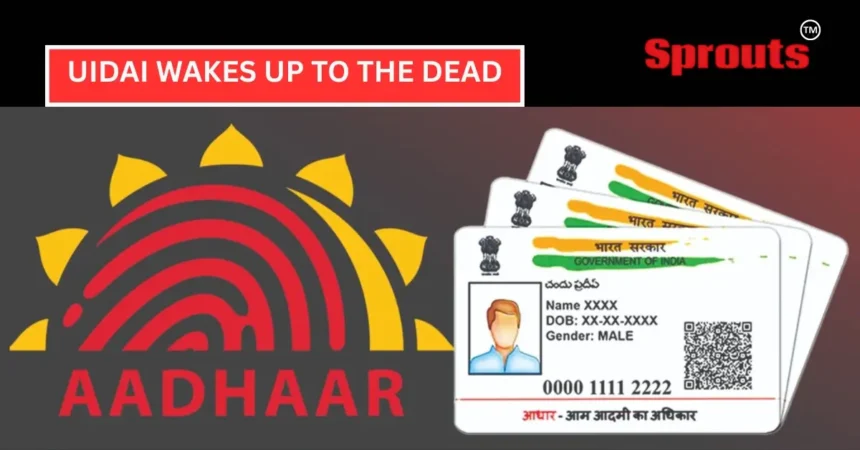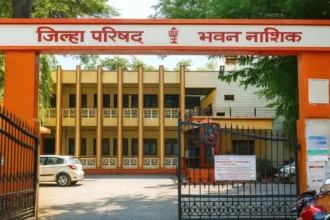UIDAI Wakes Up to the Dead
• 1.17 Cr Ghost Aadhaar IDs Deactivated
• Dead Men Tagged: Aadhaar’s Identity Crisis
• Aadhaar Cleans House—Years Too Late
Unmesh Gujarathi
Sprouts News Exclusive
Contact: +91 9322755098
- UIDAI Wakes Up to the Dead
- • 1.17 Cr Ghost Aadhaar IDs Deactivated
- • Dead Men Tagged: Aadhaar’s Identity Crisis
- • Aadhaar Cleans House—Years Too Late
- UIDAI Deletes 1.17 Crore Aadhaar Numbers—Years Late
- Click Here To Download the News Attachment
- Death Database Access Sparks Cleanup, But Too Little Too Late
- Parliamentary Disclosure Confirms Systemic Neglect
- Over-Enrolment and Ghost Identities Across States
- Voluntary Death Reporting Tool Is Toothless
- Lacking Data Governance and Exit Protocols
- Also Read: ₹272 Cr Water Conservation Scam in Pune: Fake Docs, Collusion & Farmer Betrayal.
- Systemic Flaws Undermine Digital Trust
UIDAI has deactivated 1.17 crore Aadhaar numbers of deceased individuals after years of criticism over inactive identities. The Sprouts News Investigation Team reveals how Aadhaar’s lack of death-tracking led to fraud, inflated data, and misuse. Experts demand lifecycle integration, legal protocols, and accountability to restore trust in India’s digital ID system.
UIDAI Deletes 1.17 Crore Aadhaar Numbers—Years Late
In a delayed step toward digital cleanup, the Unique Identification Authority of India (UIDAI) has deactivated 11.7 million Aadhaar numbers belonging to deceased individuals. The move comes after a decade of mounting criticism over Aadhaar’s failure to account for death, enabling biometric IDs of dead individuals to remain active. In April 2023, the government admitted to over 60 million Aadhaar holders being dead—roughly 6% of all issued numbers.
The Sprouts News Investigation Team (SIT) has tracked UIDAI’s slow and reactionary approach, pointing out that inactive Aadhaar numbers were still being counted in databases, affecting welfare delivery, increasing risks of fraud, and damaging the credibility of India’s largest identity system.
Click Here To Download the News Attachment
Death Database Access Sparks Cleanup, But Too Little Too Late
The Ministry of Electronics and Information Technology (MeitY) revealed that UIDAI collaborated with the Registrar General of India (RGI) to access 15.5 million death records through the Civil Registration System (CRS). Of these, only 11.7 million Aadhaar numbers were validated and deactivated. In non-CRS states, the effort lags behind with just 670,000 records submitted so far.
Experts say this is not reform but damage control. Aadhaar numbers—unlike voter rolls—were designed as once-issued, forever-valid identities. No formal ‘exit’ existed until now. UIDAI had no coordination with state birth and death registrars under the Registration of Births and Deaths Act, allowing millions of ghost identities to stay live and unverified.
Parliamentary Disclosure Confirms Systemic Neglect
In Parliament, MP Adoor Prakash flagged this Aadhaar anomaly in 2023. Then Minister of State for Electronics and IT, Rajeev Chandrasekhar, admitted that UIDAI had merely suggested RGI to include Aadhaar numbers in death certificates—there was no institutional mechanism.
Instead of data validation, UIDAI relied on demographic approximations to estimate living Aadhaar holders. This flawed method exposed the program’s deep systemic gaps. As the Sprouts News Investigation Team (SIT) notes, India’s flagship digital identity programme operated with blind spots fundamental to its purpose.
Over-Enrolment and Ghost Identities Across States
UIDAI’s credibility suffers further when viewed through state-wise Aadhaar saturation rates. Delhi, for example, shows a saturation of 133%—meaning more Aadhaar numbers exist than people. Similar over-registration is seen in Haryana (115%), Kerala (113%), Chandigarh (113%), Punjab (112%), Goa (111%), and others.
This contradicts Aadhaar’s promise as a “unique identity” system. The Sprouts News Investigation Team (SIT) found over-registration even in small UTs like Lakshadweep (110%) and Daman & Diu (107%). Meanwhile, states like Nagaland (68%), Meghalaya (71%), and Assam (85%) show under-enrolment, suggesting exclusion and access barriers.
The result: a bloated, error-prone national identity system that hampers governance, welfare, and planning.
Voluntary Death Reporting Tool Is Toothless
In response to growing public scrutiny, UIDAI launched a new feature on the myAadhaar portal allowing family members to report the death of a relative. While active in 24 states/UTs, the tool lacks legal backing, mandatory enforcement, or guaranteed verification. It remains voluntary, slow, and easy to bypass.
UIDAI has floated ideas to obtain death records from banks and telecom operators, but these are ad hoc responses. Experts argue that Aadhaar still lacks a lifecycle management framework—birth to death integration through institutional systems, not patchwork tech fixes.
Lacking Data Governance and Exit Protocols
India’s digital ID system continues to operate without clear exit protocols or data governance laws. Deactivation of an Aadhaar number raises unanswered questions: Are linked bank accounts or mobile numbers suspended? Are welfare benefits stopped? Is data archived or purged?
Without a data protection law or policy clarity, families of the deceased remain in the dark. Aadhaar continues to exist in limbo even after physical death—a paradox for a programme marketed as “the world’s most sophisticated ID system.”
Also Read: ₹272 Cr Water Conservation Scam in Pune: Fake Docs, Collusion & Farmer Betrayal.
Systemic Flaws Undermine Digital Trust
Aadhaar has faced criticism for wrongful welfare exclusions, duplicate enrolments, and flawed biometric verifications. The current deactivation drive is not a milestone—it is a confession. For years, ghost Aadhaar holders inflated statistics and diverted state resources meant for the poor and deserving.
Until Aadhaar is backed by automatic integration with civil registries, legal data handling frameworks, and mandatory KYC updates linked to death records, ghost identities will continue to haunt India’s governance systems.
UIDAI may have found the dead, but it still hasn’t built a system that works for the living.


















